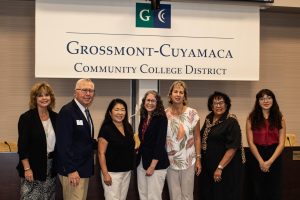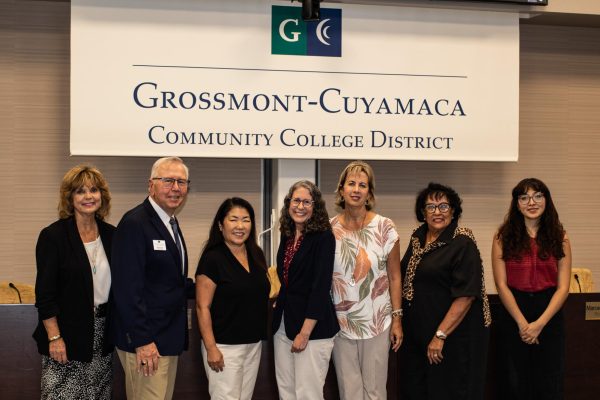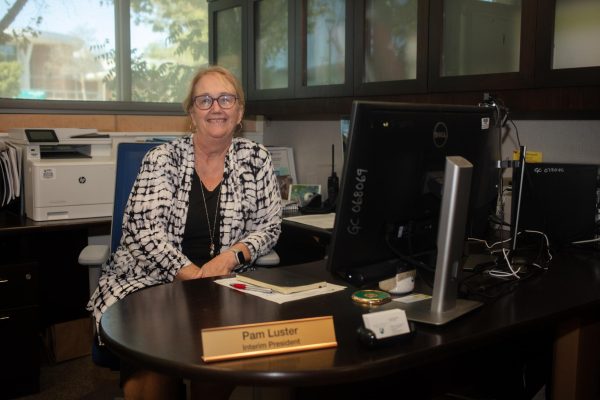Demographics Matter for Student Success
The Governing Board convened for a special workshop meeting to outline the 2021 school year, highlighting some areas of student concerns.
February 22, 2021
Student success is a priority of all schools, particularly in one area that is a major focus year in and out for the leaders of the Grossmont-Cuyamaca Community College District, which includes both Grossmont and Cuyamaca campuses.
The district’s Governing Board commenced Feb. 5 over Zoom to discuss an overview of the 2021 school year. This included some insight into the board’s district-wide goals, quality and effectiveness goals, and changes they hope to make in the near future. These changes are not yet officially decided upon among the entire board.
Every year the board determines how to improve from the previous year. A major area of coverage the school wishes to highlight is helping individual students with diverse needs succeed by removing structural barriers to their success.
According to the Society of Research in Child Development, a school’s “ethnic diversity has robust psychological benefits for multiple ethnic groups.” According to studies appearing in Sage Journals, this diversity resulted in “a lower sense of social vulnerability, defined as feeling safer at school, less victimized, and less lonely.” It should be noted these studies were done in middle schools and provided a more exaggerated result in these areas. Nonetheless, the findings still hold true in higher education campuses.
Chancellor Lynn Neault opened the discussion on the topic of goals the Governing Board would like to improve on with some “suggested changes” that “we should adopt at a future meeting.”
Neault continued: “Rather than just say ‘increase diversity and hiring,’ I said ‘ensure progress and increasing,’ which to me is a more important statement… we’re going to ensure progress in these areas.”
The ethnic make-up of higher education campuses is a common focus as it leads directly toward student success. The district has worked over the last several years to improve student success.
According to The American Council on Education, “diversity enriches the educational experience” by allowing students to “learn from those whose experiences, beliefs, and perspectives are different from our own, and these lessons can be taught best in a richly diverse intellectual and social environment.”
This, however, only highlights the comparison between instructors and students, whereas the board seeks to proportionately match the entirety of the staff, not limited to professors.
On the official GCCCD site, dating back to 2015-16, you can find statistics of student population demographics and service area population demographics. These statistics particularly highlight ethnicity, gender and age comparisons. It is important to note that these percentages are beginning to align more proportionately, but the board still has work to do to improve in this area, as was noted in this meeting.
Neault stated: “I also added ensure progress in dismantling racism and district policies processes, and practices. That was a goal to call to action of the board.” This was not included at all in the previous year’s renditions of the board’s goals.
Other board members including Elena Adams, were quick to point out that the statement felt “generic.”
“We are working towards the faculty and staff, the ethnic make-up, could really start to mirror the ethnic make-up of our student population,” Adams said. “We are trying to increase so that there is not an imbalance between faculty and staff, in terms of their ethnicity, and our student population or community population.”
Brad Monroe, the newly elected president of the Governing Board, expressed his agreement: “I agree, I think that is really something we need to work for.”
He was quick to question whether the distinction in the population was student or community population. Neault clarified that the metric typically represents the student population.
Neault provided a final edit to the statement, which read: “Ensure progress in increasing diversity in hiring to ensure the ethnicity of employees more closely reflects the diversity of our students.”
Although none of this has been formally voted on, the board was hopeful it could vote on these changes at a future meeting with the full approval of all members.
Neault stated she would “clean this up…for the board to review” and once it was reviewed by Monroe it could be put on the March board meeting for a further look.














